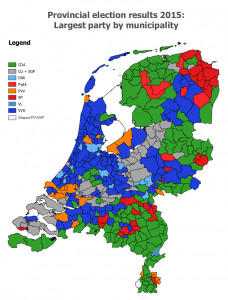Unprecedented fragmentation, a weakened government that will have to go in search for further allies to keep functioning, and a new record low for the Labour Party. Those were the main features of the outcome of last month’s provincial elections, on March 18, which determined not just the make-up of provincial legislatures but also the Dutch Senate.
Because of the continuing collapse of the Labour Party, the results also constituted the worst performance for the left overall in provincial elections since 1994, while centrist parties — the Democrats ’66, a party for the elderly and various regional lists — did well.
I contributed a rather exhaustive analysis of the election results, with plenty of maps and charts, as guest post to the World Elections blog, and it’s also on Medium. Maybe see you there!
